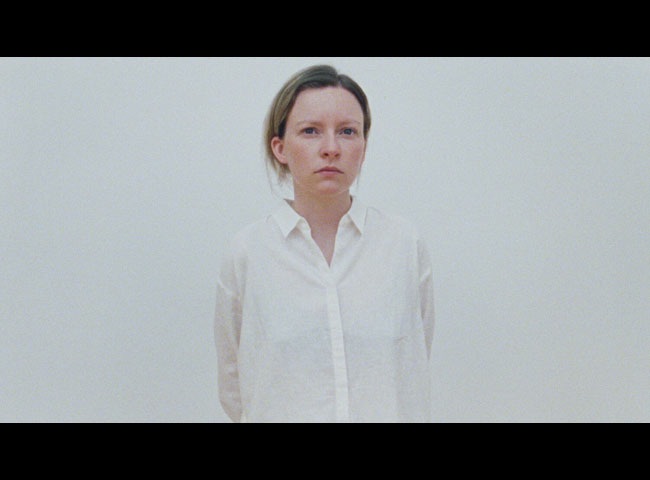Point and Line to Plane
-
Réalisé par Sofia Bohdanowicz • Écrit par Sofia Bohdanowicz
-
Canada, Islande, Russie, États-Unis • 2019 • 18 minutes • 16 mm • Couleur
- Réalisation :
Sofia Bohdanowicz - Écriture :
Sofia Bohdanowicz - Image :
Sofia Bohdanowicz, Calvin Thomas - Son :
Jacquelyn Mills, Lucas Prokaziuk - Montage :
Sofia Bohdanowicz - Interprétation :
Deragh Campbell - Musique originale :
Stefana Fratila
- Production (structure) :
Calvin Thomas - Ayant droit :
Calvin Thomas, Maison du Bonheur Films
- N° ISAN :
non renseigné
Résumé
Dévastée par la mort d’un ami, une jeune femme tente de donner du sens à cette perte en découvrant l’art de Klimt et de Kandinsky.
""Tout phénomène peut être vécu de deux façons. Ces deux façons ne sont pas arbitrairement liées aux phénomènes – elles découlent de la nature des phénomènes, de leur propriété : Extérieur – Intérieur" ainsi s’ouvre Point and Line to Plane, reprenant l’incipit énigmatique de l’essai théorique éponyme de Wassily Kandinsky (1926). Pour Sofia Bohdanowicz, jeune cinéaste prolixe et largement remarquée, ce seront les espaces où se mêlent l’art comme expérience intérieure et l’épreuve de la perte – celle de Giacomo Grisanzio, ami avec qui elle partageait une passion pour le peintre russe. Usant du détour de la fiction, la cinéaste nous dépeint son cheminement, sous les traits de Deragh Campbell, actrice de ses derniers films et déjà son alter ego pour MS Slavic 7. Figure mutique à l’écran alors que sa voix, à la douceur mélancolique, en formera l’unique commentaire sous la forme d’un journal intime nous guidant dans un parcours aux bords de la dépression. De proche en proche, dans un monde comme évidé filmé en 16mm, cela nous conduira du Canada à l’Ermitage à Saint Petersbourg, en passant par le musée Guggenheim de New-York. Avec, au cœur du film, la mise en pleine lumière de l’œuvre longtemps restée inconnue de Hilma af Klint, pionnière de l’abstraction – pour elle affaire spirituelle et sensible – et de discrets fils tissés entre les deux peintres. Ainsi avance-t-on, pas à pas, dans les méandres de réminiscences, des occasions offertes et des associations qu’elle nous suggère, là écoutant Mozart, ici munie de sa Bolex. Le film déplie dès lors une ode aux puissances vitales des images de la peinture si mal nommée abstraite, celle du cinéma, matières organiques que Sofia Bohdanowicz ramasse en un film dense et lancinant. Une histoire d’articulation et de jonction du dedans et du dehors, et aussi un acte de foi envers le cinéma et l’art comme remèdes. Et le film comme pour faire advenir et accueillir, à l’instar du plan du titre, une ligne à partir d’autant de points épars, à l’image de celles dessinées par Kandinsky s’affichant en ouverture. Une ligne dessinant une trajectoire menant à la possibilité de voir, à nouveau, comme le suggère le finale."
(N.F. - FIDMarseille)
Devastated by the death of a friend, a young woman looks for meaning in the art of Klimt and Kandinsky.
“"Every phenomenon can be experienced in two ways. These two ways are not arbitrary, but are bound up with the phenomenon – developing out of its nature and characteristics: externally – or -inwardly.” This is how Point and Line to Plane opens, by quoting the enigmatic incipit of Wassily Kandinsky’s eponymous theoretical essay (1926). For Sofia Bohdanowicz, a young prolific filmmaker whose work has been widely noticed, it is all about the spaces where art as an inner experience and the ordeal of loss meet. Here, the loss of Giacomo Grisanzio, a friend with whom she shared a passion for the Russian painter. Through a detour via fiction, the director depicts her own journey, interpreted on screen by Deragh Campbell, an actress who played in her previous films and who was already her alter ego in MS Slavic 7. She never says a word on screen, yet her soft, melancholic voice makes comments in the form of a diary that guides us through a journey on the verge of depression. Step by step, in a world filmed in 16mm which seems hollowed-out, the film takes us from Canada to the Hermitage in Saint Petersburg, by way of the Guggenheim Museum in New York. At the core of the film, the director also highlights the work of Hilma af Klint, a long-time unknown pioneer of abstraction – a spiritual and sensitive form of art for the director –, and the discreet threads connecting both painters. Thus, little by little, we follow the twists and turns of reminiscences, of given opportunities and of associations that the filmmaker suggests, here while listening to Mozart, there by using her Bolex. Then the film elaborates an ode to the vital powers of the images of ill-named abstract painting, and of cinema, both organic matters that Sofia Bohdanowicz collects in a dense and throbbing film. It is a matter of articulation and junction of the inside and the outside, and also an act of faith in cinema and art as remedies. And the film tries to make happen and welcome, like the plan in the title, a line coming out of so many scattered points, like those drawn by Kandinsky that are shown in the opening of the film. A line that draws a path towards the possibility to see, once again, as the finale suggests."
(N.F. - FIDMarseille)
Sélections et distinctions
- 2020 • FNC - Festival du Nouveau Cinéma • Montréal (Canada) • Compétition nationale
- 2020 • Sheffield DocFest • Sheffield (Royaume-Uni) • Sélection
- 2020 • FIDMarseille - Festival International de Cinéma de Marseille • Marseille (France) • Compétition Premier film, Compétition Cnap & Compétition Flash
Comment avoir accès au film ?
-
Édition DVD
- Il n'existe pas d'édition DVD à notre connaissance
-
Accès VOD
- Il n'existe pas d'accès en VOD à notre connaissance
- Distribution
- Aide sur les moyens d'accéder à un film



